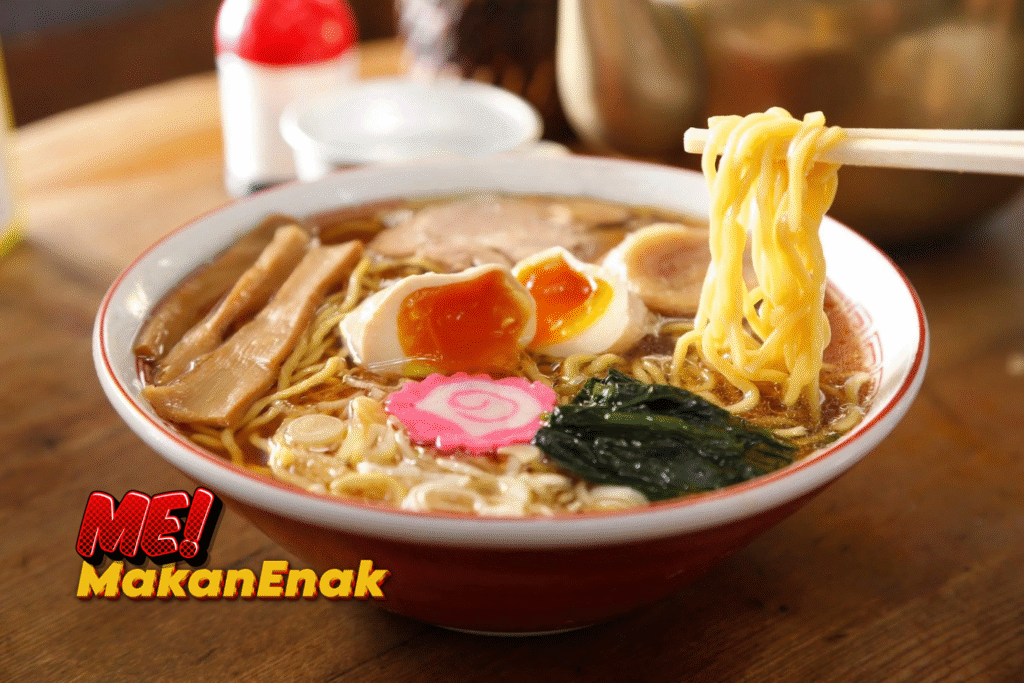makanenak – Ramen, the iconic Japanese noodle soup, has evolved far beyond its humble beginnings to become a global culinary phenomenon. What started as a simple bowl of wheat noodles in savory broth has grown into a canvas for chefs to experiment with flavors, textures, and ingredients. For food enthusiasts and travelers alike, exploring ramen is an essential way to understand Japan’s rich culinary culture.
Shoyu Ramen: The Soy Sauce Classic
Shoyu ramen, one of the most traditional varieties, features a clear, soy sauce–based broth that is both savory and slightly tangy. Typically served with curly noodles, slices of chashu pork, bamboo shoots, nori, and a soft-boiled egg, this ramen is a comforting introduction for first-time ramen eaters. Its balanced flavor makes it widely popular across Japan, from street stalls to specialty shops.
Miso Ramen: Hokkaido’s Signature Flavor
Hailing from Hokkaido, miso ramen is distinguished by its rich, hearty broth infused with fermented soybean paste. The slightly nutty and umami-rich taste pairs perfectly with thick, wavy noodles. Toppings often include corn, butter, ground pork, and vegetables, reflecting the region’s cold climate and agricultural products. Miso ramen offers warmth and depth in every bowl.
Tonkotsu Ramen: Creamy Pork Bone Delight
Originating in Fukuoka on Kyushu Island, tonkotsu ramen is famous for its creamy, opaque broth made by simmering pork bones for hours. The resulting soup is rich, flavorful, and indulgent. Thin, straight noodles are the typical choice, and toppings include chashu, green onions, kikurage mushrooms, and pickled ginger. Tonkotsu ramen is a must-try for those seeking a decadent experience.
Shio Ramen: Light and Subtle
Shio ramen, meaning “salt ramen,” offers a delicate alternative to richer varieties. Its clear broth is seasoned primarily with salt, allowing the natural flavors of chicken, seafood, or vegetables to shine. Paired with straight or slightly wavy noodles, this ramen is often garnished with scallions, kamaboko (fish cake), and nori. Shio ramen highlights the minimalist elegance of Japanese cooking.
Tsukemen: Dipping Ramen for a Modern Twist
Tsukemen, or dipping ramen, represents a modern evolution of traditional ramen. Instead of being served in the soup, noodles are presented separately alongside a concentrated dipping broth. Diners dip the noodles into the flavorful liquid, allowing them to control the intensity of the taste with each bite. This interactive style has become popular in ramen shops across Japan and abroad.
Specialty and Fusion Ramen: Creative Innovations
In recent years, chefs have introduced unique twists to ramen, blending international flavors or experimenting with unconventional ingredients. Variants like curry ramen, seafood ramen with rich miso or tomato broth, and even vegan ramen with plant-based broths showcase the adaptability of this dish. These modern interpretations highlight ramen as both a traditional comfort food and a platform for culinary creativity.
Ramen Culture: More Than Just a Meal
Ramen is deeply embedded in Japanese culture, from late-night eateries to specialty festivals. Each region boasts its own variations, reflecting local ingredients, climate, and culinary heritage. Visiting ramen shops offers more than just a meal—it’s an experience that connects visitors with Japan’s history, craftsmanship, and attention to detail.
Whether savoring the classic flavors of shoyu or exploring inventive fusion bowls, ramen invites food lovers on a journey through Japan’s rich and diverse culinary landscape. For anyone intrigued by both tradition and innovation, ramen remains a dish that continues to captivate palates around the world.


